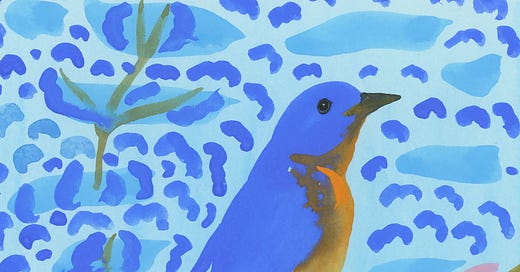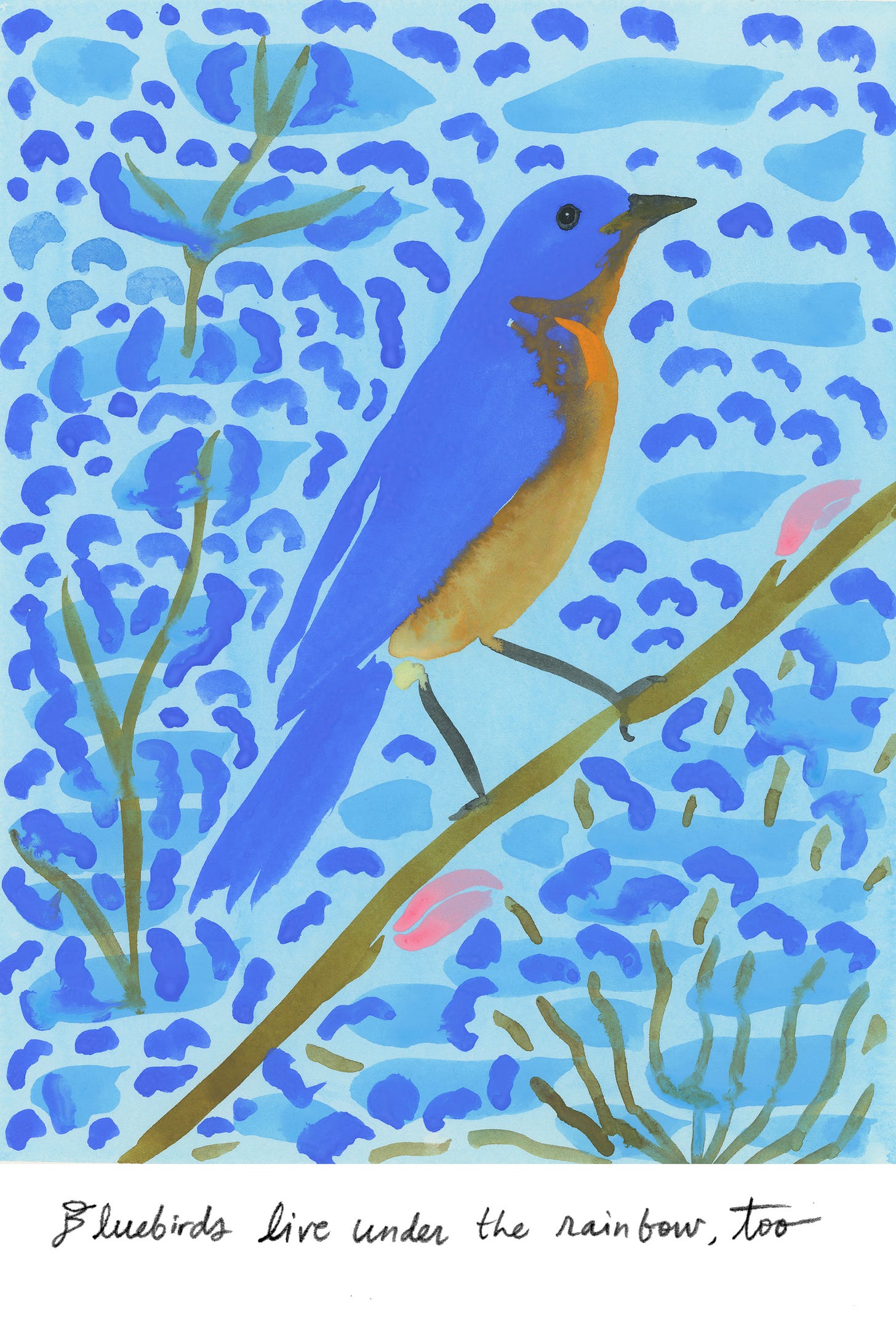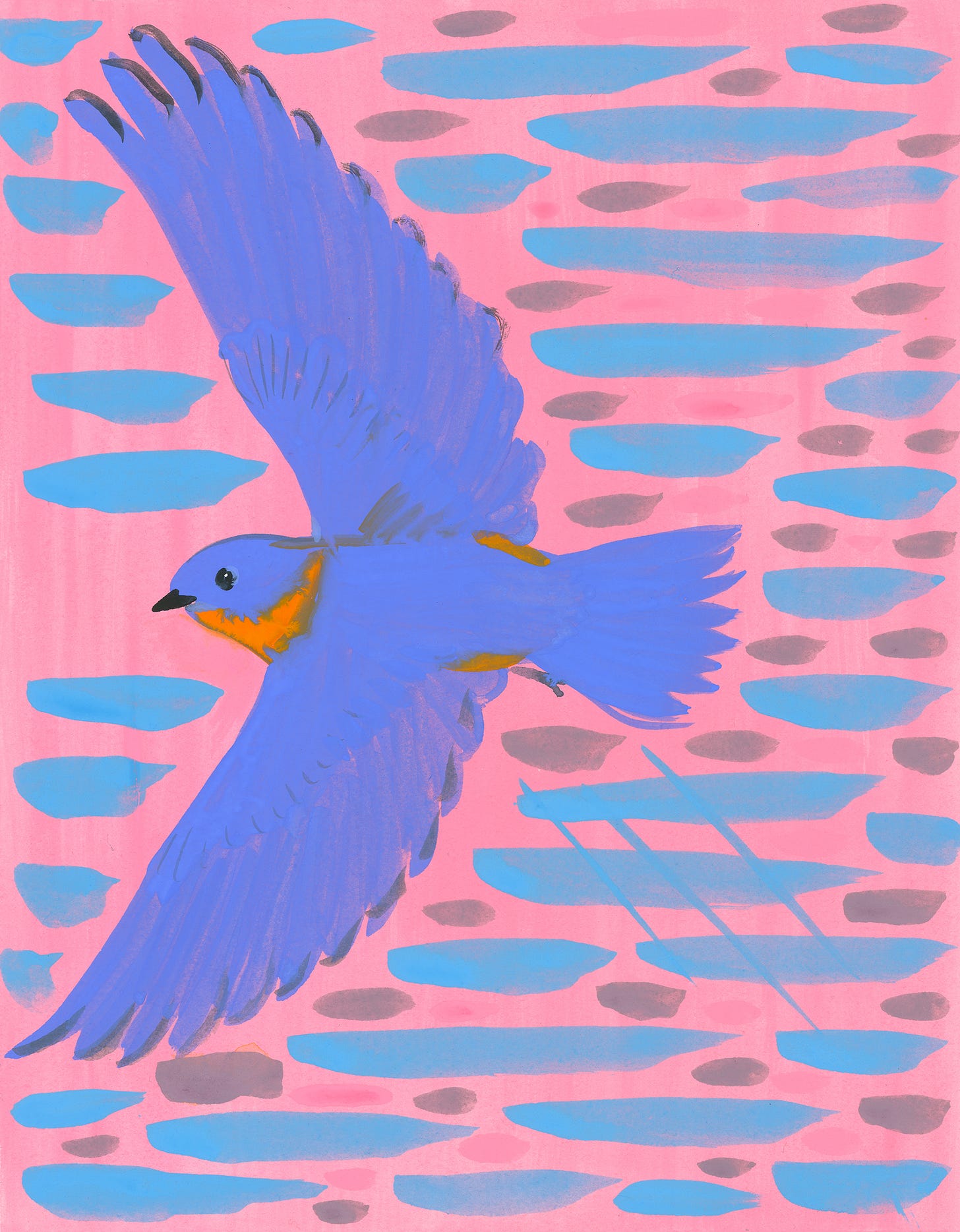Hi, friends — welcome to new readers! This is a reminder that bluebirds are actual, real creatures in the world. I find this comforting. Let’s spend a few minutes thinking about them. As always, you can reply to this email or add a comment on the website. I’d love to hear your stories. Thanks for being there. — Amy Jean
Last year, sometime in the mud season (when dirt floats above grass and gravel, sticks to shoes and paws, enters the house in chunks and whirls; no matter the strategy, it is time for dirt), we went for a quick trek on a local path. The spring streams were lively and the moss bright green. At the near beginning, a few birds joined alongside, and I was surprised to see an eastern bluebird—so blue—a little daintier than a robin but with the same plucky shape. We don’t see many around our house and so the encounter felt special, like a good sign.
Eastern bluebirds are jewel-like; their blue is sharper and brighter than jays, and they have a delicate presence. Their blue is actually an optical effect caused by the structure of their feathers—not a pigment. This structural color is created by air pockets within the feather that refract blue light while the rest of the wavelength is absorbed. And so the bird’s jewel-like quality is more than a metaphor.
Eastern bluebirds live in North America east of the Rockies, to southern Canada in the summer and year-round through Mexico and Central America to Nicaragua. They are not uncommon now, but in the mid-twentieth century their numbers plummeted due to changes in agriculture, pesticides, and the introduction of starlings and house sparrows (whose more aggressive demeanors did a number on bluebirds).
As with many stories of birds, people actually stepped in to help increase and stabilize their numbers. Bluebirds make their nests in small cavities in rotting trees, usually excavated and left behind by woodpeckers. They also like old wooden fenceposts, when available. In all cases they compete with house sparrows, who are nasty fighters. Beginning in the 1960s, campaigns to provide thousands and thousands of nesting boxes specifically for bluebirds had a huge beneficial effect.
Eastern bluebirds are very social, sometimes flocking together in a hundred or more. They communicate through song, with varying calls for varying purposes (mating, territorial, alarm, etc.). Apparently their most common calls sound like the words “truly” and “purity,” though I’m not good at this vocabulary game. Both parents help care for their young. They eat bugs, bugs, bugs, and have sharp vision to catch their dinner in the air and on the ground.
Seeing a bluebird is a ridiculous delight. They remind us of beauty in the actual living, breathing world, even in the muddiest season. They’re also a good sign that we can, in fact, be helpful—an important reminder.
Eastern bluebird links—
It is literally snowing/sleeting/storming outside right now, but there are many videos of bluebirds to enjoy [via Cornell eBird]. You can also listen to their sweet singing, here. Or look at some great close-ups, here.
DIY nest boxes at Audubon, or purchase from a local shop like this one. Short history of conservation efforts at NJ Audubon.
Somewhere over the rainbow
Bluebirds fly
<3 Judy Garland in the Wizard of Oz [YouTube]
Animal encounters in recent comments—
“ … imagine the one guy’s surprise when, high up on a cherry picker, he opened up the container to have 5–9 flying squirrels jump out and glide off into his face …” thanks to Heather for this excellent and bananas vision.
Also—
Wild Life #40 / this newsletter is a place to learn about the life around us, one bluebird of happiness at a time. I do this because I’m not sure what to do about the millions of species in danger of extinction. It means something to see and enjoy the life around us. Thanks for reading and sharing. See you next time.






Wow, that bluebird painting, the one of it sitting on a branch, is just perfection. The attitude of the body and tilt of the head... something about it just makes it seem as if it's about to flutter out of my screen.
I’ve been reading your newsletter for quite a while now. It’s been a great source of tranquility for me in a chaotic world. Your illustrations are beautiful and have been influential on my own work. Thanks for making the world a little better place!